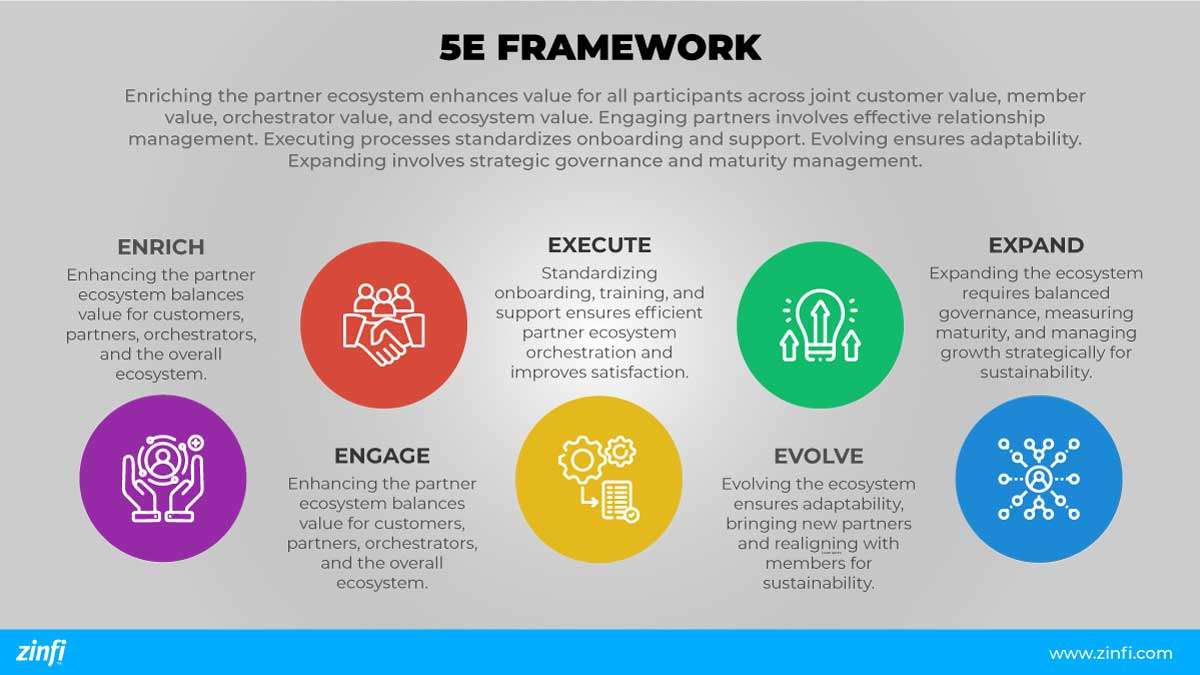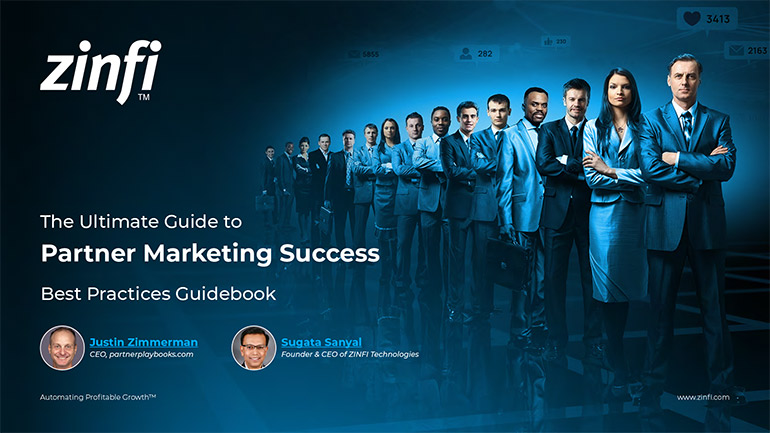Best Practices Articles

How to Orchestrate a Partner Ecosystem Using the 5E Framework
Introduction:
Orchestrating a partner ecosystem involves strategically managing and optimizing all aspects of partner relationships to drive mutual growth and success. This process is vital for businesses that rely on a network of partners, such as distributors, resellers, and service providers. Effective partner ecosystem orchestration ensures seamless collaboration, enhanced communication, and maximizes performance. This guide will explore best practices for orchestrating a partner ecosystem using the 5E framework: Enrich, Engage, Execute, Evolve, and Expand. Following these steps, organizations can create a cohesive and efficient partner ecosystem that drives sustainable growth and competitive advantage. Download our Partner Ecosystem Management guidebook to know more about the strategic tools.
Key Takeaways:
- Enrich: Enriching the partner ecosystem involves creating and enhancing value for all participants, including joint customers, individual partners, the orchestrator, and the ecosystem as a whole. This involves carefully balancing and enhancing value across four vectors: joint customer value, member value, orchestrator value, and ecosystem value. Successful value orchestration leverages network effects at the ecosystem level, creating a robust, synergistic environment.
- Engage: Engaging partners is crucial for building strong, collaborative relationships within the ecosystem. This involves how we relate to and interact with each ecosystem member and the ecosystem as a whole. Engagement orchestration encompasses the RACI (Responsible, Accountable, Consulted, Informed), rules, workflows, tools, data, reporting, and incentives. A comprehensive ecosystem platform is vital for facilitating engagement and ensuring all members are connected and engaged. Explore our engagement resources for more information. Watch the video to learn how to engage partners.
- Execute: Executing efficient processes is essential for seamless partner ecosystem orchestration. This involves standardizing onboarding, training, and support procedures to ensure consistency and efficiency. Automated tools can enhance process management by reducing manual errors and accelerating task completion. Organizations can continuously evaluate and improve partner processes to ensure their ecosystem operates smoothly, leading to better partner satisfaction and performance. Learn more about optimizing partner processes on our process automation page.
- Evolve: Evolving the ecosystem ensures it can adapt and thrive in changing environments. This includes bringing in new partners, resetting commercial terms, and re-aligning with members as joint customers seek new forms of value. Agility is critical for maintaining ecosystem health and sustainability. For strategies on enhancing agility, visit our agility page.
- Expand: Expanding the ecosystem involves governance and the ability to measure and manage the maturity of the other four dimensions. This requires a coordinated approach to ensure that value, alignment, engagement, and agility are balanced and optimized. Effective scale orchestration helps manage growth strategically, operationally, and culturally, ensuring sustainable ecosystem expansion. For more insights on scaling, check out our scaling strategies.

Summary of Key Takeaways:
Effective partner ecosystem orchestration requires a comprehensive approach encompassing the 5E framework: Enrich, Engage, Execute, Evolve, and Expand. By strategically managing these dimensions, organizations can create a dynamic and efficient partner ecosystem that drives mutual success and growth. This approach ensures seamless collaboration, enhances partner performance, and maximizes ecosystem velocity.Key Examples:
- Automotive Manufacturing: In the automotive industry, orchestrating a partner ecosystem involves coordinating with suppliers, distributors, and service providers to ensure a seamless supply chain and high-quality customer service. Implementing advanced platforms for real-time tracking and communication can enhance collaboration and efficiency.
- Consumer Electronics: Consumer electronics companies benefit from a well-orchestrated partner ecosystem by aligning with retailers, repair services, and logistics partners. Standardized processes and automated tools help manage inventory, streamline repairs, and ensure timely product deliveries.
- Energy Production: Energy companies collaborate with equipment manufacturers, service providers, and regulatory bodies. Effective partner ecosystem orchestration ensures compliance, optimizes maintenance schedules, and enhances overall operational efficiency.
- Financial Services: In financial services, a robust partner ecosystem involves working with advisors, brokers, and technology providers. Straightforward partner programs and advanced platforms help manage relationships, track performance, and ensure regulatory compliance.
- Food and Beverage: The food and beverage industry relies on a network of suppliers, distributors, and retailers. Streamlining processes and leveraging technology can improve supply chain efficiency, reduce waste, and enhance product quality.
- Healthcare Services: Healthcare providers collaborate with pharmaceutical companies, equipment suppliers, and insurance firms. Effective partner ecosystem orchestration ensures timely access to necessary resources, enhances patient care, and maintains regulatory compliance.
- Information Technology: IT companies work with software vendors, hardware manufacturers, and service providers. Advanced platforms and continuous improvement practices help manage complex projects, ensure interoperability, and drive innovation.
- Pharmaceutical Development: Pharmaceutical companies partner with research institutions, regulatory bodies, and healthcare providers. Straightforward partner programs and refined processes ensure compliance, accelerate research, and improve patient outcomes.
- Retail Industry: Retailers coordinate with suppliers, logistics providers, and marketing agencies. Advanced inventory management and customer engagement platforms enhance operational efficiency and drive sales growth.
- Telecommunications: Telecom companies collaborate with equipment manufacturers, service providers, and regulatory authorities. Effective partner ecosystem orchestration ensures reliable service delivery, regulatory compliance, and customer satisfaction.
Conclusion:
Orchestrating a partner ecosystem using the 5E framework is a multifaceted process that requires strategic planning, clear communication, and the right tools. By focusing on Enrich, Engage, Execute, Evolve, and Expand, organizations can create a dynamic and efficient partner ecosystem that drives mutual success and growth. This holistic approach ensures seamless collaboration, enhances partner performance, and drives sustainable value. Whether in automotive manufacturing, consumer electronics, energy production, financial services, food and beverage, healthcare services, information technology, pharmaceutical development, retail, or telecommunications, effective partner ecosystem orchestration is essential for achieving sustainable success and competitive advantage. Implementing these best practices can help organizations navigate the complexities of partner relationships and unlock the full potential of their partner ecosystem.Partner Ecosystem Orchestration Plan
- Define Partner Roles and Responsibilities:
- Outline clear roles and responsibilities for each partner.
- Set performance metrics and expectations.
- Establish Communication Channels:
- Implement regular communication channels for updates and feedback.
- Use advanced platforms for real-time collaboration.
- Develop Training Programs:
- Create comprehensive training programs for partners.
- Offer ongoing support and development opportunities.
- Streamline Processes:
- Standardize onboarding, training, and support processes.
- Automate routine tasks to improve efficiency.
- Implement Performance Tracking:
- Use advanced platforms to track partner performance.
- Regularly review and analyze performance data.
- Foster Continuous Improvement:
- Solicit feedback from partners and make necessary adjustments.
- Continuously evaluate and improve partner programs and processes.


Best Practices Guidebook
 The Ultimate Guide to Partner Marketing Success Best Practices
The Ultimate Guide to Partner Marketing Success Best PracticesDownload Guide
 How to Start and Scale Partner Ecosystems Best Practices
How to Start and Scale Partner Ecosystems Best PracticesDownload Guide
 The Evolution of PartnerOps: Past, Present & Future Best Practices
The Evolution of PartnerOps: Past, Present & Future Best PracticesDownload Guide
 Mastering Channel Sales: Strategies, Best Practices, and Growth Tactics for 2025
Mastering Channel Sales: Strategies, Best Practices, and Growth Tactics for 2025Download Guide
 Winning with Partner Advisory Councils: Best Practices for Partner Engagement & Growth
Winning with Partner Advisory Councils: Best Practices for Partner Engagement & GrowthDownload Guide
 The Future of Partner Ecosystems Best Practices
The Future of Partner Ecosystems Best PracticesDownload Guide
 The AI Revolution: How Technology and Talent are Shaping the Future
The AI Revolution: How Technology and Talent are Shaping the FutureDownload Guide
 Top 105 Partner Management Metrics that Matter Best Practices
Top 105 Partner Management Metrics that Matter Best PracticesDownload Guide
 Mastering PRM Integration Best Practices
Mastering PRM Integration Best PracticesDownload Guide
 Building a Sales Partner Portal with Salesforce Best Practices
Building a Sales Partner Portal with Salesforce Best PracticesDownload Guide
 Building and Managing Partner Ecosystems Best Practices
Building and Managing Partner Ecosystems Best PracticesDownload Guide
 Mastering Co-Marketing and Co-Selling Best Practices
Mastering Co-Marketing and Co-Selling Best PracticesDownload Guide
 Transforming Partner Ecosystems Best Practices
Transforming Partner Ecosystems Best PracticesDownload Guide
 Mastering Partner Ecosystems Best Practices
Mastering Partner Ecosystems Best PracticesDownload Guide
 Mastering Partner Onboarding Best Practices
Mastering Partner Onboarding Best PracticesDownload Guide
 Partner Ecosystem Management Best Practices
Partner Ecosystem Management Best PracticesDownload Guide
 B2B Marketing in the Age of Intelligence Best Practices
B2B Marketing in the Age of Intelligence Best PracticesDownload Guide
 Multi-Partner Co-Selling Best Practices
Multi-Partner Co-Selling Best PracticesDownload Guide







